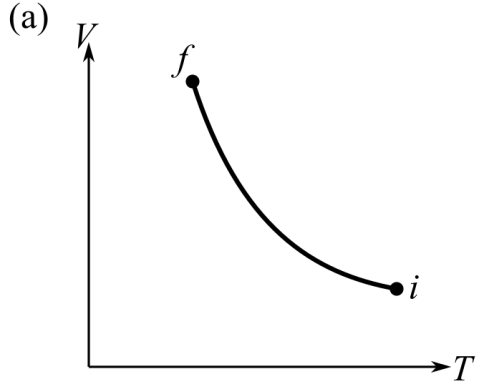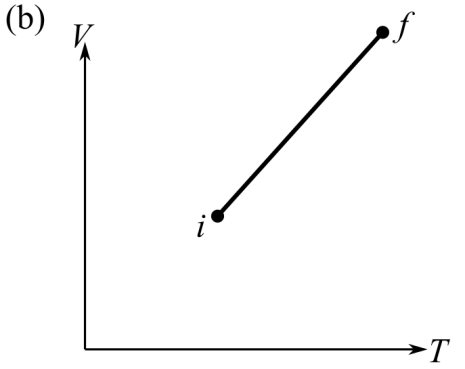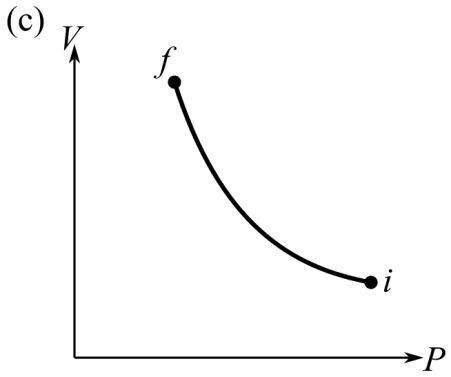
College Physics
2nd Edition
ISBN: 9780134601823
Author: ETKINA, Eugenia, Planinšič, G. (gorazd), Van Heuvelen, Alan
Publisher: Pearson,
expand_more
expand_more
format_list_bulleted
Concept explainers
Question
Chapter 12, Problem 11MCQ
To determine
The graph that would best describe the process, in which it is observed that with constant external pressure pushing down on the piston, the piston moves up leading to the volume of the gas to increase where the system has a heavy piston sitting over a cylindrcal container with gas, from the given options:



Expert Solution & Answer
Want to see the full answer?
Check out a sample textbook solution
Students have asked these similar questions
Can you help me solve this 2 question and teach me what we use to solve this
You are working during the summer at a company that builds theme parks. The company is designing an electromagnetic propulsion system for a new roller coaster. A model of a substructure of the device appears in the figure below.
Two parallel, horizontal rails extend from left to right, with one rail behind the other. A cylindrical rod rests on top of and perpendicular to the rails at their left ends. The distance between the rails is d and the length of the rails is L. The magnetic field vector B points vertically down, perpendicular to the rails. Within the rod, the current I flows out of the page, from the rail in the back toward the rail in the front.
The rod is of length d = 1.00 m and mass m = 0.700 kg. The rod carries a current I = 100 A in the direction shown and rolls along the rails of length L = 20.0 m without slipping. The entire system of rod and rails is immersed in a uniform downward-directed magnetic field with magnitude B = 2.30 T. The electromagnetic force on the rod…
Based on the graph, explain how centripetal force is affected when the hanging mass changes. Does your graph verify the relationship in the equation r = x^i + y^j = r cos ωt I + r sin ωt^j?
Chapter 12 Solutions
College Physics
Ch. 12 - Prob. 1RQCh. 12 - Prob. 2RQCh. 12 - Prob. 3RQCh. 12 - Review Question 12.4 Ken says that the temperature...Ch. 12 - Review Question 12.5 What is the difference...Ch. 12 - Prob. 6RQCh. 12 - Prob. 7RQCh. 12 - Review Question 12.8 How do we know that the Sun’s...Ch. 12 - Prob. 1MCQCh. 12 - Prob. 2MCQ
Ch. 12 - Prob. 3MCQCh. 12 - Prob. 4MCQCh. 12 - Prob. 5MCQCh. 12 - Prob. 6MCQCh. 12 - Prob. 7MCQCh. 12 - Prob. 8MCQCh. 12 - 9. How might physicists have come to know that at...Ch. 12 - 10. A cylindrical container is filled with a gas....Ch. 12 - Prob. 11MCQCh. 12 - A completely closed rigid container of gas is...Ch. 12 - Prob. 13MCQCh. 12 - Prob. 14MCQCh. 12 - Prob. 15MCQCh. 12 - Which of the following conditions are crucial for...Ch. 12 - Prob. 17CQCh. 12 - 18. Why does it hurt to walk barefoot on gravel?
Ch. 12 - 19. In the magic trick in which a person lies on a...Ch. 12 - What does it mean if the density of a gas is 1.29...Ch. 12 - How many oranges would you have if you had two...Ch. 12 - 22. Imagine that you have an unknown gas. What...Ch. 12 - Prob. 23CQCh. 12 - Describe how temperature and one degree are...Ch. 12 - Why does sugar dissolve faster in hot tea than in...Ch. 12 - 26. (a) Describe experiments that were used to...Ch. 12 - Give three examples of diffusion that are...Ch. 12 - Why do very light gases such as hydrogen not exist...Ch. 12 - Prob. 29CQCh. 12 - Explain why Earth has almost no free hydrogen in...Ch. 12 - What are the molar masses of molecular and atomic...Ch. 12 - Prob. 2PCh. 12 - The average particle density in the Milky Way...Ch. 12 - * (a) What is the concentration (number per cubic...Ch. 12 - Prob. 5PCh. 12 - 6. You find that the average gauge pressure in...Ch. 12 - Prob. 7PCh. 12 - Prob. 8PCh. 12 - Prob. 9PCh. 12 - 10. You have five molecules with the following...Ch. 12 - 11.Two gases in different containers have the same...Ch. 12 - 12. Four molecules are moving with the following...Ch. 12 - m2, what is the average pressure of the 10 tennis...Ch. 12 - * Friends throw snowballs at the wall of a...Ch. 12 - Prob. 15PCh. 12 - Prob. 16PCh. 12 - Prob. 17PCh. 12 - Air consists of many different molecules, for...Ch. 12 - Prob. 19PCh. 12 - 20. Air is a mixture of molecules of different...Ch. 12 - Prob. 21PCh. 12 - Prob. 22PCh. 12 - 23. ** A molecule moving at speed collides...Ch. 12 - Prob. 24PCh. 12 - Prob. 25PCh. 12 - * Even the best vacuum pumps cannot lower the...Ch. 12 - Prob. 27PCh. 12 - Prob. 28PCh. 12 - * The following data were collected for the...Ch. 12 - Prob. 30PCh. 12 - Prob. 31PCh. 12 - 32. * When surrounded by air at a pressure of 1.0...Ch. 12 - 33. * Some students are given the following...Ch. 12 - 34. ** You have gas in a container with a movable...Ch. 12 - Prob. 35PCh. 12 - * Bubbles While snorkeling, you see air bubbles...Ch. 12 - Prob. 37PCh. 12 - * Mount Everest (a) Determine the number of...Ch. 12 - Prob. 39PCh. 12 - Prob. 40PCh. 12 - Prob. 41PCh. 12 - 42. * Car tire dilemma Imagine a car tire that...Ch. 12 - 43. * There is a limit to how much gas can pass...Ch. 12 - Prob. 44PCh. 12 - Prob. 45PCh. 12 - 46. * In the morning, the gauge pressure in your...Ch. 12 - ** The P-versus-T graph in Figure P12.49 describes...Ch. 12 - ** The V-versus-T graph in Figure P12.50 describes...Ch. 12 - Prob. 51PCh. 12 - Prob. 52PCh. 12 - Prob. 53PCh. 12 - 55. ** A gas that can be described by the ideal...Ch. 12 - * Equation Jeopardy 3 The three equations below...Ch. 12 - Prob. 57GPCh. 12 - 58. * See the previous problem Explain how the...Ch. 12 - Prob. 59GPCh. 12 - Prob. 60GPCh. 12 - Prob. 61GPCh. 12 - Prob. 62GPCh. 12 - 63. EST * Car engine During a compression stroke...Ch. 12 - * How can the pressure of air in your house stay...Ch. 12 - 65 * Tell-all problem Tell everything you can...Ch. 12 - 66. ** Two massless, frictionless pistons are...Ch. 12 - 67. * A closed cylindrical container is divided...Ch. 12 - Prob. 68GPCh. 12 - 69. ** The speed of sound in an ideal gas is given...Ch. 12 - 70. * Using the information from problem 12.69,...Ch. 12 - Prob. 71GPCh. 12 - 73. Why is the wall tension in capillaries so...Ch. 12 - Prob. 74RPPCh. 12 - Prob. 75RPPCh. 12 - As a person ages, the fibers in arteries become...Ch. 12 - Prob. 77RPPCh. 12 - The bag and pump have a 6.76-kg mass. The volume...Ch. 12 - The bag and pump have a 6.76-kg mass. The volume...Ch. 12 - The bag and pump have a 6.76-kg mass. The volume...Ch. 12 - The bag and pump have a 6.76-kg mass. The volume...Ch. 12 - Prob. 82RPP
Knowledge Booster
Learn more about
Need a deep-dive on the concept behind this application? Look no further. Learn more about this topic, physics and related others by exploring similar questions and additional content below.Similar questions
- Can you help me to solve this two questions can you teach me step by step how to solve it.arrow_forwardGiven: ruler 11.56 g, small washer 1.85 g each, large washer 24.30g each Use the data in Data Tables 4 and 5 to experimentally determine the mass of your ruler. Use one of your 2 trials with 1 small washer at 0 cm, one of your 2 trials with 2 small washers at 0 cm, and one of your 2 trials with 3 small washers at 0 cm to find three experimental values for the mass of the ruler. How do you experimentalls determine the mass?arrow_forwardCompare the 3 experimental masses of your ruler to the measured mass of your ruler (Data Table 1) by calculating the percent error for each experimental value. Which trial provided the best data for determining the mass of the ruler? Please help, I am not sure how to calculate this. Thanks!arrow_forward
- Please help, everytime I try to input the data only one point shows on the graph. Please graph unsing centripetal force, Fc, versus V E2 from Activity 1. Include a line of best fit and record the equation of the line. Thank you!arrow_forwardPlease help, everytime I try to input the data only one point shows on the graph. Graph of centripetal force, Fc, versus V E2 from Activity 1. Include a line of best fit and record the equation of the line.arrow_forwardBased on your graph, explain how centripetal force is affected when the hanging mass changes. Does your graph verify the relationship in the equation r = x^i + y^j = r cos ωt I + r sin ωt^j?arrow_forward
- Did your experiment results in Data Table 3 verify, to within a reasonable experimental error, the condition of equilibrium of Equation 6: Στanti-clockwise = Στclockwise? Support your response with experimental data. My data shows that they are not equal to each other. So what does this mean? Thanks!arrow_forwardPlease help, everytime I try to input the data only one point shows on the graph. Graph of centripetal force, Fc, versus V E2 from Activity 1. Include a line of best fit and record the equation of the line.arrow_forwardExplain how your experiment met the condition for equilibrium in Equation 4: ΣFvertical = ΣFy = 0.arrow_forward
- Can i get answer and solution for this question and can you teach me What we use to get the answer.arrow_forwardCan i get answer and solution and can you teach me how to get it.arrow_forwardConsider a image that is located 30 cm in front of a lens. It forms an upright image 7.5 cm from the lens. Theillumination is so bright that that a faint inverted image, due to reflection off the front of the lens, is observedat 6.0 cm on the incident side of the lens. The lens is then turned around. Then it is observed that the faint,inverted image is now 10 cm on the incident side of the lens.What is the index of refraction of the lens?arrow_forward
arrow_back_ios
SEE MORE QUESTIONS
arrow_forward_ios
Recommended textbooks for you
 Physics for Scientists and Engineers: Foundations...PhysicsISBN:9781133939146Author:Katz, Debora M.Publisher:Cengage Learning
Physics for Scientists and Engineers: Foundations...PhysicsISBN:9781133939146Author:Katz, Debora M.Publisher:Cengage Learning Physics for Scientists and EngineersPhysicsISBN:9781337553278Author:Raymond A. Serway, John W. JewettPublisher:Cengage Learning
Physics for Scientists and EngineersPhysicsISBN:9781337553278Author:Raymond A. Serway, John W. JewettPublisher:Cengage Learning Physics for Scientists and Engineers with Modern ...PhysicsISBN:9781337553292Author:Raymond A. Serway, John W. JewettPublisher:Cengage Learning
Physics for Scientists and Engineers with Modern ...PhysicsISBN:9781337553292Author:Raymond A. Serway, John W. JewettPublisher:Cengage Learning Principles of Physics: A Calculus-Based TextPhysicsISBN:9781133104261Author:Raymond A. Serway, John W. JewettPublisher:Cengage Learning
Principles of Physics: A Calculus-Based TextPhysicsISBN:9781133104261Author:Raymond A. Serway, John W. JewettPublisher:Cengage Learning Physics for Scientists and Engineers, Technology ...PhysicsISBN:9781305116399Author:Raymond A. Serway, John W. JewettPublisher:Cengage Learning
Physics for Scientists and Engineers, Technology ...PhysicsISBN:9781305116399Author:Raymond A. Serway, John W. JewettPublisher:Cengage Learning College PhysicsPhysicsISBN:9781938168000Author:Paul Peter Urone, Roger HinrichsPublisher:OpenStax College
College PhysicsPhysicsISBN:9781938168000Author:Paul Peter Urone, Roger HinrichsPublisher:OpenStax College

Physics for Scientists and Engineers: Foundations...
Physics
ISBN:9781133939146
Author:Katz, Debora M.
Publisher:Cengage Learning

Physics for Scientists and Engineers
Physics
ISBN:9781337553278
Author:Raymond A. Serway, John W. Jewett
Publisher:Cengage Learning

Physics for Scientists and Engineers with Modern ...
Physics
ISBN:9781337553292
Author:Raymond A. Serway, John W. Jewett
Publisher:Cengage Learning

Principles of Physics: A Calculus-Based Text
Physics
ISBN:9781133104261
Author:Raymond A. Serway, John W. Jewett
Publisher:Cengage Learning

Physics for Scientists and Engineers, Technology ...
Physics
ISBN:9781305116399
Author:Raymond A. Serway, John W. Jewett
Publisher:Cengage Learning

College Physics
Physics
ISBN:9781938168000
Author:Paul Peter Urone, Roger Hinrichs
Publisher:OpenStax College